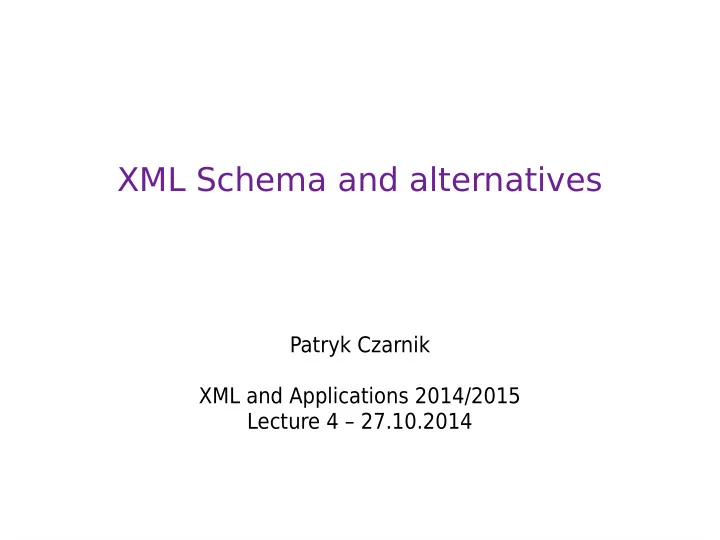

XML Schema and alternatives Patryk Czarnik XML and Applications 2014/2015 Lecture 4 – 27.10.2014
Some possibilities of XML Schema we have not learnt too much Deriving complex types by restriction restriction of values set, not necessarily of structure super type more general, subtype more specifjc Substitution groups virtual elements that can be substituted with other ones Wildcards (any and anyAtribute) allow to insert any tags or tags from given namespaces Nillable elements marking elements as “nonexisting” with xsi:nil attribute personally, I don't like this idea... Specifying actual type with xsi:type in documents 2 / 21
Some drawbacks of XML Schema Verbose syntax, specifjcation hard to understand Limited power of expression deterministic model required no choice between: text content and element content attribute and element content-aware model not available (in 1.0) no value-aware constraints other than simple identity constraints (in 1.0) Extending types only by appending model fragments at the end of a sequence no direct support for adding new elements to a choice available with other techniques: element groups or substitution groups 3 / 21
Alternatives DTD – obviously RELAX NG ( Regular Language for XML Next Generation ) by James Clark and Murata Makoto OASIS (2001) and ISO (2003) standard Schematron by Rick Jellifge (1999), developed at Academia Sinica (T aiwan), ISO standard (2006) Examplotron by Eric van der Vlist, project active in 2001-2003 XML Schema 1.1 W3C Recommendation, 2012 borrows some ideas from the alternatives, mainly Schematron 4 / 21
Simple example in all standards DTD <!ELEMENT person (first-name+, last-name)> <!ELEMENT first-name (#PCDATA)> <!ELEMENT last-name (#PCDATA)> XML Schema <xs:schema xmlns:xs="http://www.w3.org/2001/XMLSchema"> <xs:element name="person" minOccurs="0" maxOccurs="unbounded"> <xs:complexType> <xs:sequence> <xs:element name="first-name" type="xs:string" maxOccurs="unbounded" /> <xs:element name="last-name" type="xs:string" /> </xs:sequence> </xs:complexType> </xs:element> </xs:schema> 5 / 21
Simple example in all standards Relax NG – XML syntax <grammar xmlns="http://relaxng.org/ns/structure/1.0"> <start> <element name="person"> <oneOrMore> <element name="first-name"> <text/> </element> </oneOrMore> <element name="last-name"> <text/> </element> </element> Relax NG – compact syntax </start> element person { </grammar> element first-name { text }+ element last-name { text } } 6 / 21
Simple example in all standards Schematron <schema xmlns="http://purl.oclc.org/dsdl/schematron"> <pattern> <title>Person rules</title> <rule context="/person"> <assert test="count(first-name) >= 1">Person should contain one or more first names.</assert> </rule> <rule context="/person"> <assert test="count(last-name) = 1">Person should contain exactly one last name.</assert> </rule> <rule context="/person"> <assert test="not(*[local-name() != 'first-name' and local-name() != 'last-name'])">Person should contain no other elements.</assert> </rule> </pattern> </schema> Note: This is not the primary intended use of Schematron 7 / 21
Simple example in all standards Examplotron :) <person> <first-name>Adam</first-name> <first-name>Maria</first-name> <last-name>Abacki</last-name> </person> 8 / 21
Relax NG – basic ideas Clear theoretical basis: Tree automata with regular expressions specifying content in each node The same model with appropriate restrictions is used by theoreticians to model DTD or XML Schema, but as a kind of “reverse engineering” Compact and readable XML syntax Even more compact plain text syntax available Model components such as elements, attributes, or text nodes may be mixed together in defjnitions Modularisation available through defjne / ref mechanism Equivalent to DTD parameter entities or XSD groups, but with some additional operations to enhance convenience No direct support for simple types, but referring to XML 9 / 21 Schema types is possible.
Schematron – basic ideas Approach difgerent from grammar-based DTD, XSD, and RelaxNG: XPath expressions specify assertions that must hold for instance documents (and elements within them) High power of expression Less convenient (than grammar rules) to write structural defjnitions Offjcial implementation: translation of Schematron scheme to XSLT XSLT evaluates expressions and report errors Other implementations available, also for Schematron rules embedded in XML Schema defjnitions XML Schema 1.1 covers most typical Schematron use cases. Probably XSD 1.1 will replace Schematron at all... 10 / 21
Non-deterministic model Ambiguous model: It is not possible to state which particle of the model defjnition is matched, even if whole document is known. example: (A,A,A)+|(A,A)+ for document AAAAAA Non-deterministic model similar to (non-)LL(1) grammars, but extended to trees: During one-pass parsing, it is not possible to determine the appropriate defjnition particle for a current element when only the start tag of the element is seen Some models may be determined just by defjnition rearrangement, e.g.: A, A?, A? → A, (A, A?)? But some models may not; notable example: (A, B)*, A? XML Schema avoids non-deterministic models! 11 / 21
Model forbidden in XML Schema, valid in Relax NG <list> <odd/> <even/> <odd/> <even/> <odd/> ... </list> <element name="list"> <oneOrMore> <element name="odd"/> <element name="even"/> </oneOrMore> <optional> <element name="odd"/> </optional> </element> 12 / 21
Choice between text and element We'd like to allow both formats: <phone>1234567</phone> <phone><cc>48</cc><ac>22</ac><main>123456</main><int>1313</int></phone> No possibility in XML Schema (other than mixed content) No problem in RelaxNG: <element name="phone"> <choice> <text/> <group> <optional><element name="cc"/></optional> <optional><element name="ac"/></optional> <element name="main"/> <optional><element name="int"/></optional> </group> </choice> </element> 13 / 21
Choice between attribute and element Similarly as before, we want to allow both <section title="Introduction"> ... and <section> <title>What does <q>Be or not to be</q> mean in fact?</title> ... Relax NG solution: <element name="section"> <choice> <attribute name="title"/> <element name="title"> <ref name="text-model"/> </element> </choice> <ref name="text-model"/> </element> 14 / 21
Value-aware constraints Relations and constraints other than equality <order> <order-date>2014-01-20</order-date> <delivery-date>2014-01-25</delivery-date> <item> ... <value>199.90</value> </item> <item> ... <value>20</value> </item> <value>219.90</value> </order> 15 / 21
Value-aware constraints – Schematron solution <pattern> <title>Order</title> <rule context="order"> < assert test="delivery-date >= order-date"> Delivery is not possible before order.</assert> </rule> <rule context="order"> < assert test="value = sum(item/value)"> Order value must be equal to the sum of item values.</assert> </rule> </pattern> 16 / 21
Value-aware constraints – XSD 1.1 solution <xs:complexType name="Order"> <xs:sequence> ... <xs:element name="order-date" type="xs:date"/> <xs:element name="delivery-date" type="xs:date"/> ... <xs:element name="item" type="OrderItem" maxOccurs="unbounded"/> <xs:element name="value" type="xs:decimal"/> ... </xs:sequence> <xs: assert test="delivery-date >= order-date"> <xs: assert test="value = sum(item/value)"> </xs:complexType> 17 / 21
Content-aware model We want to choose one of models depending on the value of a fjeld (attribute or element), e.g: <order> ... <payment method=" transfer "> <due-date>2014-02-07</due-date> </payment> </order> <order> ... <payment method=" card "> <card-no>4400-1234-1234-1234</card-no> <holder>Adam Abacki</holder> <exp-date>2014-12-31</exp-date> </payment> </order> 18 / 21
Recommend
More recommend